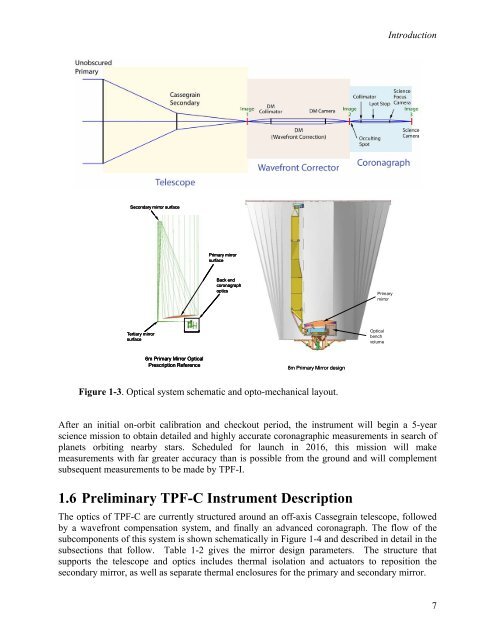TPF-C Technology Plan - Exoplanet Exploration Program - NASA
TPF-C Technology Plan - Exoplanet Exploration Program - NASA
TPF-C Technology Plan - Exoplanet Exploration Program - NASA
You also want an ePaper? Increase the reach of your titles
YUMPU automatically turns print PDFs into web optimized ePapers that Google loves.
Introduction<br />
Secondary mirror surface<br />
Primary mirror<br />
surface<br />
Back end<br />
coronagraph<br />
optics<br />
Primary<br />
mirror<br />
Tertiary mirror<br />
surface<br />
Optical<br />
bench<br />
volume<br />
6m Primary Mirror Optical<br />
Prescription Reference<br />
8m Primary Mirror design<br />
Figure 1-3. Optical system schematic and opto-mechanical layout.<br />
After an initial on-orbit calibration and checkout period, the instrument will begin a 5-year<br />
science mission to obtain detailed and highly accurate coronagraphic measurements in search of<br />
planets orbiting nearby stars. Scheduled for launch in 2016, this mission will make<br />
measurements with far greater accuracy than is possible from the ground and will complement<br />
subsequent measurements to be made by <strong>TPF</strong>-I.<br />
1.6 Preliminary <strong>TPF</strong>-C Instrument Description<br />
The optics of <strong>TPF</strong>-C are currently structured around an off-axis Cassegrain telescope, followed<br />
by a wavefront compensation system, and finally an advanced coronagraph. The flow of the<br />
subcomponents of this system is shown schematically in Figure 1-4 and described in detail in the<br />
subsections that follow. Table 1-2 gives the mirror design parameters. The structure that<br />
supports the telescope and optics includes thermal isolation and actuators to reposition the<br />
secondary mirror, as well as separate thermal enclosures for the primary and secondary mirror.<br />
7
















